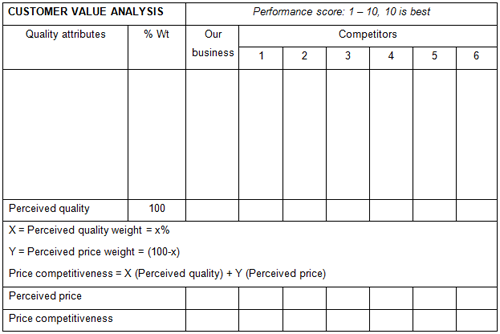Companies succeed by providing superior customer value. And value is simply ‘quality’ however the customer defines it, offered at the right price.
While this strategic principle is simple, it is also very powerful. For survival and success, it is far more important to commit yourself to superior quality and customer value than to commit yourself to attaining financial goals. Superior customer value is the best leading indicator of market share and competitiveness. (Think Jet Airways.) And market share and competitiveness in turn drive the achievement of long-term financial goals such as profitability, growth, and shareholder value. (Think HDFC, TCS and Punjab Tractors.)
The first step in achieving leadership in market-perceived quality and value is to understand what causes customers in your targeted market to make their decisions – to decide that one product offers better value than another. Understanding that is the most central objective of a customer value analysis. The factors that contribute to quality in the customer’s mind need not be mysterious. Customers will gladly tell you what they are. A customer value analysis uses information from customers to show how customers make decisions in your marketplace. With this information, you have the means to know what to change to ensure that more of them will buy from you.

Some companies focus on few (sometimes, one) customers to deliver extraordinary value. Particularly when they are dealing with the world’s premiere corporations. For example, Abhishek Industries in Ludhiana, the flagship company of the Trident Group, has built an outstanding record for quality, consistency and on-time delivery with Wal Mart. In turn, Wal Mart has recognized Abhishek Industries as the International Supplier of the Year 2001. At the core of this recognition is customer perceived quality/value.
In another example, perhaps an international benchmark, Sundram Fasteners in Chennai has been recognized by General Motors as the Best Supplier for six consecutive years. General Motors has not rejected a single radiator cap from Sundram Fasteners in eight years! This amazing performance is clearly customer-driven.
The IMC Ramkrishna Bajaj National Quality Award criteria provide the best framework for determining whether a company is organized to achieve dominance in market-perceived quality. The criteria also provide an essential checklist, helping organizations ensure that they are attacking all the key issues they must address to become world-class. (The IMC-Bajaj criteria are a demystified version of the Malcolm Baldrige criteria.)
The IMC-Bajaj criteria do not provide the best guide to day-to-day management. Select corporates that have adopted the IMC-Bajaj (or Baldrige) criteria can get so wrapped up in fixing shortcomings found in an IMC-Bajaj self-examination that they miss key market signals and fail to take the vital few actions that would achieve leadership in market-perceived quality. Thus, they miss their opportunity to achieve dominant market share. The goal is to manage an organization that constantly makes the right moves to deliver what the customer will want tomorrow!
To drive a company wisely, we need a few clear, widely accepted principles:
- Companies succeed by providing superior customer value
- Companies should track the customer value they provide through a method like customer value analysis
- Companies should use a method of business planning that allows for ‘action learning’, such as the war-room method of conducting business meetings
- Companies need a comprehensive strategic navigation system to provide data on both financial performance and customer value performance.
CREDITS: Suresh Lulla, Founder & Mentor, Qimpro Consultants Pvt. Ltd.